What advancements enhance concrete strength and durability?

Strong 8k brings an ultra-HD IPTV experience to your living room and your pocket.
Concrete is one of the most widely used construction materials due to its strength, durability, and versatility. However, to meet the ever-evolving demands of modern construction, advancements in concrete technology have significantly improved its strength and durability. These advancements include innovations in materials, mix design, and application techniques, which collectively contribute to the development of more robust and long-lasting concrete structures. This article explores the latest advancements enhancing concrete strength and durability, focusing on materials, technologies, and practices that drive improvements in concrete performance.
For More Industry Insight: https://www.persistencemarketresearch.com/market-research/cement-additives-market.asp
1. High-Performance Concrete (HPC)
High-Performance Concrete (HPC) represents a significant advancement in concrete technology, designed to offer superior strength and durability compared to traditional concrete mixtures.
Material Composition: HPC is formulated using a combination of high-quality materials, including finely ground cements, mineral additives, and chemical admixtures. Key components such as superplasticizers, silica fume, and fly ash are incorporated to enhance the concrete's mechanical properties and resistance to environmental factors.
Improved Strength: HPC can achieve compressive strengths significantly higher than conventional concrete, often exceeding 6,000 psi (pounds per square inch). This increased strength results from optimized mix designs and the use of advanced materials that improve the bonding between cement particles and aggregates.
Enhanced Durability: HPC offers improved durability characteristics, including resistance to abrasion, chemical attacks, and freeze-thaw cycles. The dense microstructure of HPC reduces permeability, minimizing the ingress of harmful substances that can lead to deterioration.
2. Fiber-Reinforced Concrete (FRC)
Fiber-Reinforced Concrete (FRC) incorporates various types of fibers into the concrete mix to enhance its mechanical properties and durability.
Types of Fibers: Fibers used in FRC include steel, synthetic, glass, and natural fibers. Each type of fiber imparts unique benefits, such as increased tensile strength, crack resistance, and impact resistance.
Crack Control: The addition of fibers helps to control and mitigate the formation of cracks by distributing stresses more evenly throughout the concrete matrix. This results in improved structural integrity and reduced maintenance needs.
Enhanced Toughness: FRC exhibits enhanced toughness and resistance to dynamic loading, making it suitable for applications such as industrial floors, pavements, and seismic-resistant structures. The fibers improve the ductility of concrete, allowing it to absorb more energy before failure.
3. Self-Healing Concrete
Self-healing concrete is an innovative technology designed to automatically repair cracks and damage that occur over time.
Healing Agents: Self-healing concrete incorporates healing agents such as microcapsules or bacteria that activate upon contact with moisture. These agents release substances that fill and seal cracks, restoring the concrete's structural integrity.
Durability Benefits: By addressing cracks and damage as they occur, self-healing concrete enhances the long-term durability of structures. This reduces the need for manual repairs and extends the service life of concrete elements.
Applications: Self-healing concrete is particularly valuable in critical infrastructure projects such as bridges, highways, and water-retaining structures, where minimizing maintenance and repair costs is essential.
4. High-Strength and Ultra-High-Strength Concrete
Advancements in mix design and materials have led to the development of High-Strength Concrete (HSC) and Ultra-High-Strength Concrete (UHSC), which offer exceptional mechanical properties.
High-Strength Concrete (HSC): HSC is characterized by its compressive strength, typically ranging from 6,000 to 10,000 psi. It is achieved through the use of high-quality cements, optimized aggregate gradation, and advanced curing techniques.
Ultra-High-Strength Concrete (UHSC): UHSC surpasses HSC in terms of strength, with compressive strengths exceeding 10,000 psi. UHSC incorporates fine materials such as silica fume and advanced mixing processes to achieve its exceptional performance. It is used in specialized applications where extreme strength and durability are required.
Structural Efficiency: Both HSC and UHSC allow for the design of more slender and efficient structures, reducing material usage and construction costs. Their high strength also enables the construction of taller and more resilient buildings.
5. Nanotechnology in Concrete
Nanotechnology involves the manipulation of materials at the nanoscale to enhance concrete properties at a microscopic level.
Nano-Additives: Nanotechnology introduces additives such as nano-silica, nano-alumina, and nano-titanium dioxide into the concrete mix. These additives improve the bonding between cement particles and aggregates, resulting in a denser and more durable matrix.
Enhanced Properties: The use of nano-additives enhances several properties of concrete, including compressive strength, tensile strength, and resistance to chemical attacks. The improved microstructure contributes to reduced permeability and increased durability.
Self-Cleaning Surfaces: Nano-coatings applied to concrete surfaces can provide self-cleaning properties by breaking down organic pollutants upon exposure to sunlight. This results in cleaner and more visually appealing surfaces.
6. Sustainable and Eco-Friendly Concrete
Sustainability is a growing focus in concrete technology, with advancements aimed at reducing the environmental impact of concrete production and usage.
Recycled Materials: The use of recycled materials such as crushed concrete aggregates and industrial by-products (e.g., fly ash, slag) helps to reduce the consumption of virgin resources and lower the carbon footprint of concrete production.
Low-Carbon Cements: Innovative cements with lower carbon emissions, such as those incorporating alternative binders or carbon capture technologies, contribute to more sustainable concrete practices. These cements aim to reduce greenhouse gas emissions associated with traditional cement production.
Green Building Standards: Sustainable concrete practices align with green building standards and certifications, such as LEED (Leadership in Energy and Environmental Design). These standards promote the use of eco-friendly materials and practices to achieve environmental and energy efficiency goals.
7. Advanced Curing Techniques
Proper curing is essential for achieving optimal concrete strength and durability. Recent advancements in curing techniques have improved the quality and performance of concrete.
Chemical Curing Agents: Chemical curing agents, such as curing compounds and membranes, are applied to the surface of freshly placed concrete to retain moisture and promote proper hydration. These agents help to prevent premature drying and improve the final strength and durability of the concrete.
Accelerated Curing: Accelerated curing methods, such as steam curing and hot-water curing, speed up the hydration process and achieve higher early-age strength. These methods are particularly useful in precast concrete production and cold-weather conditions.
Environmental Controls: Advances in environmental controls, such as temperature and humidity regulation, ensure consistent curing conditions and reduce the risk of defects. Automated curing systems can monitor and adjust conditions to maintain optimal curing parameters.
8. Innovative Mix Designs
Innovative mix designs focus on optimizing the proportions and types of materials used in concrete to enhance its strength and durability.
Optimized Aggregate Gradation: Advanced mix designs use carefully selected and graded aggregates to achieve a well-packed and cohesive concrete matrix. This reduces voids and improves the overall density and durability of the concrete.
High-Performance Admixtures: The development of new admixtures, such as rheology-modifying agents and corrosion inhibitors, enhances specific properties of concrete, such as workability, resistance to corrosion, and long-term durability.
Blended Cements: Blended cements that combine different types of cements and supplementary materials (e.g., slag, fly ash) offer improved performance characteristics. These cements can be tailored to meet specific requirements for strength, durability, and sustainability.
9. Durability Testing and Monitoring
Advancements in durability testing and monitoring techniques provide valuable insights into the performance and longevity of concrete structures.
Non-Destructive Testing (NDT): Non-destructive testing methods, such as ultrasonic pulse velocity and rebound hammer testing, assess the quality and integrity of concrete without causing damage. These techniques help identify potential issues and ensure that concrete meets strength and durability requirements.
Long-Term Monitoring: Monitoring systems, such as embedded sensors and data logging devices, provide real-time information on concrete performance and environmental conditions. These systems help track the health of concrete structures and assess their durability over time.
Predictive Modeling: Predictive modeling tools use data and simulations to forecast the performance and lifespan of concrete structures. These models help engineers and designers make informed decisions about material selection, mix design, and maintenance strategies.
Note: IndiBlogHub features both user-submitted and editorial content. We do not verify third-party contributions. Read our Disclaimer and Privacy Policyfor details.


